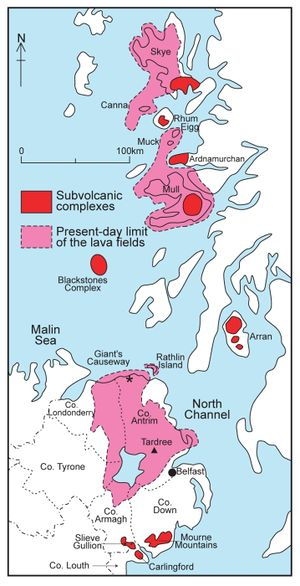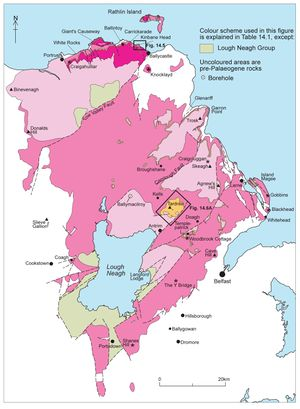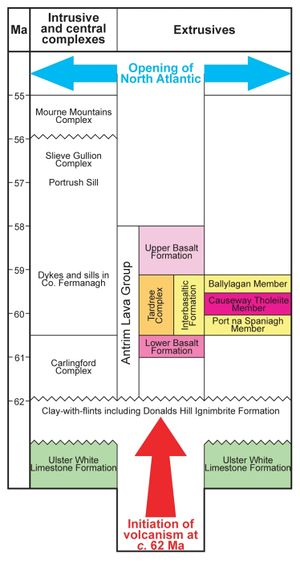Antrim Lava Group, Palaeogene extrusive igneous rocks, Northern Ireland
| Mitchell, W I (ed.). 2004. The geology of Northern Ireland-our natural foundation. Geological Survey of Northern Ireland, Belfast. |
M R Cooper
Antrim Lava Group












The Antrim Lava Group consists mainly of basaltic rocks that cover much of Co. Antrim and parts of Co. Londonderry and north Co. Armagh (P947861). Its outcrop extends only a short distance offshore beyond the east coast of Co. Antrim into the North Channel and into the Malin Sea north of the outcrop on Rathlin Island. The former extent of the Antrim Lava Group onshore is not known. However, based on comparisons with the island of Mull, where it is estimated that 1000 m of basalt lava was eroded [1], if a similar thickness had been removed in Northern Ireland, then it is probable that the lavas extended far beyond their present outcrop. Supporting evidence for an erosive event of similar magnitude is found in the presence of basalt outliers on Slieve Gallion [H 813 896] and Knocklayd [D 115 364]. The outliers in Co. Armagh, between the southern margin of the Antrim Plateau and Slieve Gullion are an indication of the minimum southerly extent of the basalt lava field (P947861) and (P947862).
The earliest evidence of explosive volcanism at the base of the Antrim Lava Group is vent agglomerates, ash cones and layers of pyroclastic tuff in north Co. Antrim. Chalky and basaltic tuff, some 60 m thick, occur at the base and in lower levels of the Lower Basalt Formation, and extend for at least 7 km from the source between Ballintoy and Ballycastle (P947862) [2]. At Kinbane [D 088 439], chalky tuff overlain by basaltic tuff is exposed in the cliffs southwest of the headland (P947863). Although the volcanic vent that produced these pyroclastic deposits is now concealed, the chalk outcrop at Kinbane is riddled with subsidiary vents filled by shattered chalk, basaltic agglomerate and doleritic intrusions [2][3]. At Carrickarade [D 062 448], the footpath and rope bridge provide excellent views of an agglomerate-filled vent (P948024). At White Rocks [C 886 407] east of Portrush, vents exposed on the foreshore are also filled with chalk boulders and basalt agglomerate.
Within the Antrim Lava Group there are very few examples of sedimentary deposits intervening between the basalt lava flows. However, in the area east of Cookstown, the Coagh Conglomerate Member [4] represents a fluvial deposit that is located near the base of the Lower Basalt Formation (P947862). The conglomerate crops out in a stream [H 898 789] 800 m ENE of Coagh Bridge and is underlain by about 5m of basalt lava. It comprises about 6 m of clast-supported conglomerate composed of well-rounded pebbles and cobbles of basalt in a dark greyish green clay matrix with multicoloured chips and rounded granules of red clay. Very rare clasts of flow-banded porphyritic rhyolite are recorded in the conglomerate [5].
The early phase of localised explosive volcanism was followed by the widespread eruption of basalt lava flows of the Lower Basalt Formation. Lava reached the surface from vents and along NNW-aligned fissures and has a maximum thickness of 531m [6] in the Langford Lodge borehole (P947862). Flows are exposed in numerous cliff sections both at the coast and inland, particularly in quarries. In Co. Antrim they are exposed at Cave Hill [J 325 799], Black Head [J 488 934] north of Whitehead (P948025), the Gobbins [J 485 976] on Island Magee and in Glenariff Forest Park [D 217 206].
Lava flows of the Lower Basalt and Upper Basalt formations are usually not more than 10 m thick and can be divided into three parts. Flow bases commonly exhibit concentrations of vesicles (P948026) that were originally gas bubbles which develop into vesicle cylinders with a pipe-like form that extends upwards through a flow (P948027). Central portions of flows are often massive with irregular columnar jointing. Flow tops are frequently vesicular but are most commonly weathered to purplish red lithomarge (palaeosol) and may be capped by a layer of bright red, weathered volcanic dust. Vesicles are referred to as amygdales when they are filled with zeolite minerals precipitated from hot groundwater.
Petrographical and geochemical studies demonstrate that basalt lava from both the lower and upper formations consists of fine-grained, olivine basalt (olivine tholeiites) composed of plagioclase feldspar, olivine, augite and opaque minerals [7], [8]. Plagioclase, as the dominant phase, is either randomly orientated or more rarely will show a flow alignment and fluxion around olivine phenocrysts ( (P948083) ).
Tholeiitic andesite lava flows (formerly referred to as mugearite) with an outcrop length of up to 8 km occur towards the centre and top of the Lower Basalt Formation near Antrim and Templepatrick [9], [10], [11] and at Larne [12] in south and southeast Co. Antrim. They are fine-grained and flow banded with a flaggy to massive aspect in exposures in the Stoneyford River at The Y Bridge [J 201 723] and in streams at Woodbrook Cottage [J 229 850] near Templepatrick (P947862) .
The Interbasaltic Formation normally consists of 10–15 m of orange-red lateritic palaeosol, but also in parts may still retain relict igneous and mineral textures in the purplish red, deeply weathered basalt and is referred to as lithomarge. Alteration has resulted in an iron-rich laterite composed mainly of the secondary clay mineral kaolinite and containing at least 30% iron as Fe2O3 and 5% titanium as TiO2. Bauxite or aluminous laterite is more restricted in distribution than the ferruginous laterite and was produced by the weathering of silicic volcanic rocks and ash. The dominant clay mineral is gibbsite and the aluminium content as Al2O3 is at least 50%.
In north Co. Antrim, the period of time in which the Interbasaltic Formation was formed was associated with the eruption of the mainly quartz-tholeiites of the Causeway Tholeiite Member (P948097). As the first flow crossed the land surface it filled several valleys known to have existed in lavas at the top of the Lower Basalt Formation. Trapped there, the ponded lava cooled slowly forming the famous columns of the Giants Causeway (P948028) and (P948029), now a World Heritage Site. Individual flows of this member may be divided into a lower colonnade, entablature and an upper colonnade [13], as seen at the Giant’s Organ. In addition to the effects of contraction and cooling of the lava other factors may have contributed to the formation of the columnar jointing. The first prerequisite seems to have been that lava flow had virtually ceased. Curvilinear jointing at the Giant’s Harp would seem to indicate however, that residual movement did occur during crystallisation. Textural homogeneity may also have been essential and is born out by the petrography of the tholeiites which are all composed of very fine-grained augite, plagioclase feldspar, glass and opaques with rare phenocrysts of feldspar and olivine [14]. There is also a close relationship between the occurrence of a colonnade and entablature and the presence of rocks associated with water including river and lake sediments, pillow lavas and hyaloclastite breccias. It seems likely that water displaced by lava flows of the Causeway Tholeiite Member in the valleys flooded the upper surface of the flow, modifying the cooling regime and encouraging the formation of multi-tiered columnar flows. Flooding of the top cooling surface by rain probably also aided the formation of the upper colonnade. Spectacular cliffs at Port Noffer on the Giant’s Causeway expose the Lower Basalt Formation, Interbasaltic Formation and lowest two flows of the Causeway Tholeiite Member.
In north Co. Antrim, extrusion of the Causeway Tholeiite Member led to the formation of two separate interbasaltic horizons (P948097). The lower horizon, the Port na Spaniagh Member, is represented by the red laterite at the Giant’s Causeway which consists of 15 m of completely weathered basalt of the Lower Basalt Formation with residual masses of relatively unweathered basalt known as Giant’s Eyes. At Craigahulliar quarry [C 883 389] the member includes lacustrine mudstone and siltstone with well-preserved deciduous leaf impressions, and a 6m bed of lignite that was worked for fuel. Below the sediments is a pahoehoe lava surface with small domes and collapsed blisters indicating sub-aerial cooling and subsequent flooding [15]. The upper bed, the Ballylagan Member, which rarely exceeds 1 m in thickness, is the weathered top of the Causeway Tholeiite Member and is developed only intermittently between Craigahulliar quarry [16] and Ballycastle.
In central Co. Antrim, silicic igneous activity during interbasaltic times produced the rhyolite lavas and pyroclastic rocks of the Tardree Rhyolite Complex (P947864), the volcanic vent at Sandy Braes [J 206 960] and 430 m of rhyolite penetrated in a borehole at Templepatrick [17]. Outliers of the Upper Basalt Formation in central Co. Antrim are underlain by siliceous bauxite of the Interbasaltic Formation that formed by weathering of the acidic volcanic rocks produced by the Tardree volcano.
Small, isolated acidic intrusions, that are probably contemporaneous with the Tardree Rhyolite Complex, intrude the Lower Basalt Formation at Shane’s Hill, and the Silurian greywacke at Ballygowan [J 190 570] between Dromore and Hillsborough in Co. Down (P947862). The Shane’s Hill intrusion [J 065 532], east of Portadown, has a roughly rectangular outline and consists of xenolithic and xenocrystic rhyodacite and latite, most probably of volcanic origin [18]. Petrographic analysis reveals a complex intrusive history that commenced with minute fractures in cooled plutonic rocks of diorite, monzonite and granite composition being invaded by magma of basaltic or intermediate composition that quenched to a brown glass. Subsequent intrusion by the later rhyodacite/latite magma entrained and partially remelted fragments of the plutonic rocks and erupted at the surface having penetrated the overlying basalt lavas. Outcrops consist mainly of pale grey to white rhyodacite. However, this dominant colour is secondary and is the result of hydrothermal alteration of the original dark grey lithology, which is now restricted to small, sharp-edged patches in exposures. Xenocrysts consist mainly of rounded quartz, orthoclase (with residual spots of plagioclase due to alteration), plagioclase and acicular pyroxene (primarily augite) or amphibole.
The maximum thickness recorded for the Upper Basalt Formation is 346m in the Ballymacilroy borehole [J 057 976] [19] although the largest part of the outcrop occurs north of the Tow Valley Fault and on the eastern side of the Antrim Plateau (P947862). Its present distribution indicates that the new lava flows overstepped the Lower Basalt Formation onto Dalradian, Carboniferous and Mesozoic rocks beyond the western edge of the Antrim Plateau. These flows also originated from NNW-orientated fissures and vents and at first encountered a vegetated and wet land surface of lateritised basalt that gave rise to flow-ploughing into pre-existing soil deposits [20]. The Upper Basalt Formation is divided into a lower aphyric group and an upper olivine-phyric, flow-banded group that are separated by a layer of grey bauxite which is 9 m thick at Agnew’s Hill [D 327 015] [21]. Although texturally and chemically distinct, it is nevertheless believed that olivine fractionation was the main differentiation process in both groups. At the top of the formation the flow-banded, olivine-phyric lava probably indicates a source in close proximity to the outcrop. North of the Tow Valley Fault, the association of thin layers of pahoehoe lava, spatter ramparts and of scoriaceous and oxidised vent material indicates close proximity to active fissures. In the formation outcrop south of the Carnlough Fault (P947862) there is an association between the upper, flow-banded, lavas and flow-banded dolerite plugs at Craigcluggan [D 293 080] and Skeagh [D 303 060]. The outcrop between Garron Point and Broughshane is related to the dolerite plug at Trosk [D 263 196].
Geochemical trends for major and minor elements in the Lower Basalt and Upper Basalt formations show that there is a progression towards mantle depletion in the latter formation, particularly in east and south Co. Antrim where there is a thick Lower Basalt Formation [22]. However, in the Antrim Plateau northwest of the Tow Valley Fault, the Lower Basalt Formation is either very thin or possibly absent in some places, such as at Binevenagh [C 692 302]. Geochemical trends in the Upper Basalt Formation in that area more closely resemble those for the Lower Basalt Formation in south and east Co. Antrim. This reflects the melting of a less depleted mantle source northwest of the Tow Valley Fault with lava of the Upper Basalt Formation often being the first products derived from that new mantle source.
References
- ↑ Walker, G P L. 1971. The distribution of amygdale minerals in Mull and Morven (western Scotland). In: Murty, T V V G G R K, and Roa, S S (eds.). Studies in Earth Sciences, W. D. West commemorative volume, 181–94.
- ↑ 2.0 2.1 Wilson, H E, and Manning, P I. 1978 Geology of the Causeway Coast. Memoir of the Geological Survey of Northern Ireland, Sheet 7. HMSO, Belfast.
- ↑ Emeleus, C H, and Preston, J. 1969. Field excursion guide to the Tertiary Volcanic rocks of Ireland. Belfast.
- ↑ Cameron, I B, and Old, R A. 1997. Geology of the country around Cookstown. 1:50 000 Geological Sheet 27 (Cookstown). Geological Survey of Northern Ireland. Technical Report GSNI/97/7.
- ↑ Patterson, E M. 1955. The Tertiary lava succession in the western part of the Antrim plateau. Proceedings of the Royal Irish Academy, 57B, 155–78.
- ↑ Manning, P I, Robbie, J A, and Wilson, H E. 1960. Geology of Belfast and the Lagan Valley. Memoir of the Geological Survey of Northern Ireland. HMSO, Belfast.
- ↑ Lyle, P. 1980. A petrological and geochemical study of the Tertiary basaltic rocks of northeast Ireland. Journal of Earth Sciences, Royal Dublin Society, 2, 137–52.
- ↑ Lyle, P. 1985. The geochemistry and petrology of Tertiary basalts from the Binevenagh area, County Londonderry. Irish Journal of Earth Sciences, 7, 59–64.
- ↑ Lyle, P, and Thompson, S J. 1983. The classification and chemistry of the Tertiary intermediate lavas of Northeast Ireland. Scottish Journal of Geology, 19, 17–27.
- ↑ Thompson, S J. 1997. Geology of the country around Antrim. 1:50 000 Geological Sheet 28 (Antrim). Geological Survey of Northern Ireland. Technical Report GSNI/97/6.
- ↑ Geological Survey of Northern Ireland 1994. Antrim, Northern Ireland Sheet 28. Solid and Drift Geology. 1:50 000. (Keyworth, Nottingham: British Geological Survey).
- ↑ Geological Survey of Northern Ireland 1994. Larne, Northern Ireland Sheet 21. Solid and Drift Geology. 1:50 000. (Keyworth, Nottingham: British Geological Survey).
- ↑ Lyle, P, and Preston, J. 1997/8. The influence of eruptive conditions on joint development in the Causeway Tholeiite Member of the Tertiary Antrim Lava Group, Northern Ireland. Irish Journal of Earth Sciences, 16, 19–32.
- ↑ Lyle, P, and Preston, J. 1993. Geochemistry and volcanology of the Tertiary basalts of the Giant’s Causeway area, Northern Ireland. Journal of the Geological Society, London, 150, 109–20.
- ↑ Lyle, P. A geological excursion guide to the Causeway Coast. W & G Baird Ltd. Second printing, 1998.
- ↑ Geological Survey of Northern Ireland 1998. Causeway Coast, Northern Ireland Sheet 7. Solid Geology. 1:50 000. (Keyworth, Nottingham: British Geological Survey).
- ↑ Old, R A. 1975. The age and field relationships of the Tardree Tertiary Rhyolite Complex, County Antrim, Northern Ireland. Bulletin of the Geological Survey of Great Britain, 51, 21–40.
- ↑ Geological Survey of Northern Ireland 1997. Northern Ireland. Solid Geology (second edition). 1:250 000. (Keyworth, Nottingham: British Geological Survey).
- ↑ Thompson, S J. 1979. Preliminary report on the Ballymacilroy No. 1 borehole, Ahoghill, Co. Antrim. Open File Report No. 63, Geological Survey of Northern Ireland. Belfast.
- ↑ Wilson, H E. 1965. Lava ploughing in the Tertiary Basalts of County Antrim. Geological Magazine, 10, 538–40.
- ↑ Lyle, P, and Patton, D J S. 1989. The petrography and geochemistry of the Upper Basalt Formation of the Antrim Lava Group in northeast Ireland. Irish Journal of Earth Sciences, 10, 33–41.
- ↑ Lyle, P. 1988. The geochemistry, petrology and volcanology of the Tertiary lava succession of the Binevenagh-Benbraddagh area of County Londonderry. Irish Journal of Earth Sciences, 9, 141–52.